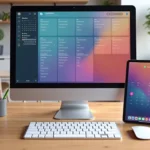Imagine you’re staring at a daunting pile of work—a never-ending sea of emails, project tasks, or textbook chapters. Your mind feels like a juggler trying to keep too many balls in the air. Suddenly, it hits you: There’s no way I can do all of this.
But what if you could break that overwhelming chaos into smaller, more manageable pieces? What if you could transform an impossible workload into bite-sized tasks that feel achievable? That’s exactly what chunking psychology offers—a powerful cognitive strategy that helps you not just survive the mental load but thrive in the process.
Chunking isn’t just a fancy term from psychology textbooks; it’s a game-changer for anyone looking to boost memory, learn new skills, or tackle complex subjects. Whether you’re prepping for exams, picking up a new language, or training for a career milestone, chunking can make it easier—and dare I say, enjoyable?—to retain and apply what you learn.
Table of Contents
What Is Chunking, and Why Does It Work?
Chunking, at its core, is about grouping smaller bits of information into larger, meaningful units. It’s how your brain organizes the flood of data it receives daily. Think of chunking as your brain’s filing system, neatly bundling related information into folders so it’s easier to store and retrieve.
A Relatable Metaphor: The Grocery List
Let’s say you’re heading to the store without a list (bold move). Instead of trying to remember 15 random items, you group them: milk, eggs, and butter under “dairy,” apples and bananas under “fruit,” and so on. Voilà! Suddenly, what seemed impossible to recall feels manageable. That’s chunking in action.
How Chunking Improves Memory Retention in Professional Skills Training
Imagine this: it’s your first day at a new job, and your brain’s already doing cartwheels trying to keep up with onboarding docs, processes, and a parade of names you’re sure will vanish by lunchtime. Professional training can feel like trying to sip from a firehose, but chunking? That’s your secret weapon to slow things down and actually make sense of it all.
Why It Works in Professional Training
Chunking breaks things down into bite-sized pieces you can actually wrap your head around. Instead of cramming an entire workflow into your brain in one go, you group related tasks into logical clusters. It’s like sorting laundry—keep the socks with the socks, and the shirts with the shirts. Suddenly, it’s a whole lot easier to handle.
Example:
Say you’re learning to use some fancy new CRM software. Rather than memorizing every single feature (and risking a total brain meltdown), you can chunk it into categories like this:
- Data Input: Customer profiles, contact records.
- Analytics: Sales reports, performance dashboards.
- Automation: Email sequences, task reminders.
By sorting things this way, you don’t just remember them better—you start seeing how it all fits together like pieces of a puzzle.
How to Make It Work for You
- Sketch out workflows or mind maps to visually group related ideas.
- Come up with acronyms or catchy phrases to make key points stick.
- Revisit your chunks regularly to lock them into your long-term memory—because let’s face it, “use it or lose it” is a real thing.
Chunking Psychology for Learning New Languages Faster
Learning a new language can feel like trying to cram an entire dictionary into your brain while juggling grammar rules and tricky pronunciations. But chunking? It’s like having a roadmap that breaks the journey into manageable stops, making the whole process way less overwhelming.
Why It Works
Our brains love patterns—it’s like their jam. When you group vocabulary into themes, like greetings, food, or travel phrases, you’re tapping into your brain’s natural ability to sort and store information.
Example:
Instead of cramming random words like “hello,” “goodbye,” and “please” one by one, group them under something like “Basic Courtesies.” The same goes for verbs like “eat,” “drink,” and “order”—stick them under “Restaurant Vocabulary.” It’s all about learning in context, so when you’re actually out and about, the right phrases pop into your head like magic.
Leveling Up Your Chunking Game
- Phrase Chunking: Focus on useful phrases you’ll actually use, like “How much is this?” instead of memorizing single words.
- Grammar Clusters: Group grammar rules by purpose—think conjugations for past, present, and future tenses. It’s like organizing tools in a toolbox.
- Thematic Learning: Organize vocab by themes like travel, shopping, or “Help, I’m lost!” situations.
Tip:
Apps like Duolingo and Anki are pros at using chunking to teach vocab in context. It’s like having a personal coach that makes sure everything sticks where it should.
Read More On: What Is Chunking in Cognitive Psychology
Best Chunking Techniques for Preparing for Exams Without Burnout
Preparing for exams often feels like a high-stakes game of “how much can I shove into my brain before test day?” Spoiler alert: cramming is a fast track to burnout and only leaves you with short-term memory scraps. Chunking, on the other hand, is like the cheat code for smarter, less stressful studying.
Why Chunking Works for Studying
Chunking helps you break your study material into bite-sized pieces, making it way less overwhelming. Instead of flipping endlessly through your notes and feeling like you’re getting nowhere, you focus on small, manageable chunks. It’s like tackling a huge pizza one slice at a time—it’s satisfying and gives you a sense of progress.
How to Use Chunking for Exam Prep
- Sort by Topic: Split your syllabus into topics or chapters.
- Break It Down: Under each topic, pick 3–5 main ideas to focus on.
- Group Related Info: Chunk similar concepts together. For example, in history, group events by time period or cause-and-effect relationships—it’s like creating mini storylines to make things stick.
Example:
If you’re gearing up for a biology exam, you could chunk it like this:
- Cells: Learn their structure, function, and how they divide.
- Photosynthesis: Understand the process, why it matters, and what comes out of it.
- Genetics: Cover Mendel’s laws, Punnett squares, and DNA structure.
How to Avoid Burnout
- Keep study sessions short and sweet with breaks in between.
- Use active recall—test yourself on each chunk to make sure it’s sinking in.
- Celebrate the small wins! Every chunk you master is a step closer to acing that exam. Give yourself a pat on the back or treat yourself—you’ve earned it!
The Role of Chunking in Building Long-Term Memory for Technical Subjects
Technical subjects like coding, engineering, or medicine can feel like tackling a massive, complicated puzzle with thousands of tiny pieces. Chunking helps you piece it all together, step by step, and makes sure the finished picture sticks in your brain.
Why Chunking Works for Technical Subjects
These fields often build on themselves, like stacking blocks—if the foundation’s shaky, the whole thing comes crashing down. Chunking helps you nail the basics before moving to the advanced stuff, creating a solid framework for deeper learning.
Example:
If you’re diving into programming, here’s how you can chunk it:
- Syntax Basics: Start with the building blocks—variables, data types, and operators.
- Control Structures: Learn how to direct the flow with loops, conditionals, and switch cases.
- Problem Solving: Once you’ve got the basics down, focus on algorithms, debugging, and optimizing code.
Master each of these chunks one at a time, and suddenly, coding doesn’t seem like such a mountain to climb.
Take It Up a Notch: Spaced Repetition
Pair chunking with spaced repetition to lock everything into your long-term memory. It’s like revisiting each chunk at just the right time, so it stays fresh in your mind. Over time, these review sessions turn tricky concepts into second nature.
Neurological Processes Behind Chunking and Its Impact on Cognitive Efficiency
Let’s nerd out for a second: chunking works because it’s totally in sync with how our brains like to process and remember stuff.
Your Brain’s Memory Limits
Here’s the deal—your working memory can only juggle about 4–7 pieces of information at a time (starting to see why phone numbers are broken into chunks?). Chunking groups those bits into bigger, more meaningful pieces, so your brain doesn’t feel like it’s running out of storage space.
What’s Happening Under the Hood:
- The prefrontal cortex—your brain’s short-term memory hub—gets a lighter workload when you use chunking. It’s like giving it a well-organized to-do list instead of a messy pile of tasks.
- The hippocampus, which handles turning short-term memories into long-term ones, loves neat, organized chunks. They’re easier to store and way quicker to find later.
Why Chunking Rocks
- Cuts Down Overload: Breaking things into bite-sized pieces makes even complicated stuff easier to handle.
- Speeds Up Recall: Organized chunks create stronger mental “roads,” so finding what you need is faster.
- Helps You Spot Patterns: Structured chunks make it easier to connect the dots and see the bigger picture.
Chunking isn’t just smart—it’s like giving your brain a cheat sheet for tackling tough stuff.
Teaching Chunking Techniques to Children for Academic Success
Teaching kids how to chunk information is like giving them a cheat code for life—it’s a skill that’ll help them crush it in school and beyond. Let’s face it, kids often get overwhelmed by too much info, and chunking shows them how to sort through the chaos and focus on what matters.
Chunking Tips for Kids
- Storytelling: Turn lessons into fun, easy-to-follow stories that group related ideas together.
- Visual Tools: Use flashcards, charts, or diagrams to create bite-sized chunks of information they can see and connect with.
- Interactive Games: Make learning hands-on by turning concepts into games where kids can group items or ideas into categories.
Example:
When learning multiplication tables, break it down. Focus on patterns like multiples of 2, 5, and 10 separately. It’s way less intimidating than tackling the whole table at once, and it keeps them zoned in on one chunk at a time.
Helping Kids Chunk on Their Own
Get kids in the habit of asking questions like:
- What’s the most important part of this?
- How does this fit with what I already know?
By teaching them how to chunk, you’re giving them a tool they’ll use forever—kind of like training wheels for their brain. Once they get the hang of it, there’s no stopping them!
Practical Tips for Mastering Chunking Psychology
Ready to try chunking for yourself? Here are some actionable steps:
- Start Small: Don’t try to chunk everything at once. Begin with a single task or subject and build from there.
- Use Visual Tools: Flowcharts, mind maps, and color-coding can help reinforce chunks.
- Practice Regularly: Like any skill, chunking improves with practice. Make it a habit to group related information in your daily life.
- Reflect on Your Process: After using chunking for a task, ask yourself: What worked? What didn’t? How can I improve?
Reflective Questions to Ponder
- What’s one area of my life where I feel overwhelmed by information? How could chunking help me manage it?
- How can I apply chunking to a skill or subject I’ve been struggling with?
- What tools or techniques could make chunking more effective for me?
Conclusion: Unlock Your Potential with Chunking
Chunking isn’t just some fancy learning trick—it’s a total lifesaver. It’s all about taking that overwhelming mess, breaking it into bite-sized pieces, and making things way easier to handle. It’s like turning a tangled set of Christmas lights into neat little sections you can actually work with.
Whether you’re tackling a new job, picking up a new language, or helping your kid ace their spelling test, chunking makes the impossible feel possible. It’s not about cramming your brain full—it’s about making what you learn stick for the long haul.
So, the next time you’re faced with something that feels huge and impossible, take a breath. Remember, you don’t have to scarf the whole elephant down at once. Take it one chunk at a time—you’ve totally got this!
FAQ
How does chunking enhance learning and memory?
Chunking involves grouping individual pieces of information into larger, meaningful units, making it easier to retain and recall data. This method leverages the brain’s natural tendency to recognize patterns, thereby enhancing memory efficiency.
Can chunking be applied to skill acquisition in sports?
Yes, athletes often use chunking to break down complex movements into manageable units, allowing for smoother execution and better performance under pressure.
What are some common techniques used in chunking?
Common chunking techniques include using acronyms, mnemonics, or organizing information into meaningful categories or sequences.
How does chunking relate to working memory capacity?
Chunking can be a form of data suppression that allows for more information to be stored in short-term memory. Rather than verbal short-memory measured by the number of items stored, chunking works as data compression when it comes to redundant information and it allows for more information to be stored in short-term memory.
Is chunking beneficial for children’s academic success?
Teaching chunking techniques to children can enhance their memory performance and learning outcomes. By organizing information into meaningful chunks, children can improve their understanding and recall of academic material.
Image Credit: istockphoto







